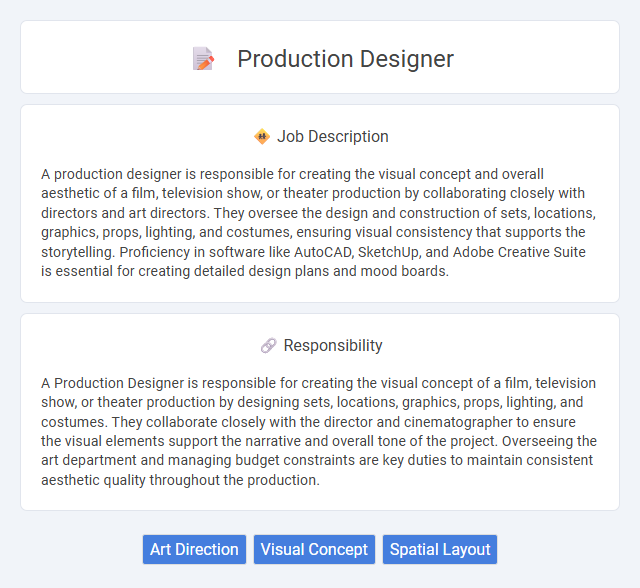
A production designer is responsible for creating the visual concept and overall aesthetic of a film, television show, or theater production by collaborating closely with directors and art directors. They oversee the design and construction of sets, locations, graphics, props, lighting, and costumes, ensuring visual consistency that supports the storytelling. Proficiency in software like AutoCAD, SketchUp, and Adobe Creative Suite is essential for creating detailed design plans and mood boards.
Individuals who possess strong creativity, attention to detail, and the ability to collaborate effectively with directors and technical teams are more likely to excel as production designers. Those comfortable working under pressure in fast-paced environments with tight deadlines may find this role suitable, while people who prefer solitary or less dynamic work settings might struggle. The job often demands long hours and adaptability, suggesting that candidates with resilience and strong organizational skills have a higher probability of succeeding.
Qualification
A Production Designer typically requires a bachelor's degree in film production, graphic design, or fine arts, with strong skills in visual storytelling and spatial design. Proficiency in software such as AutoCAD, SketchUp, and Adobe Creative Suite is essential for creating detailed set designs and concept art. Experience in theater, film, or television production enhances the ability to collaborate effectively with directors, art directors, and costume designers.
Responsibility
A Production Designer is responsible for creating the visual concept of a film, television show, or theater production by designing sets, locations, graphics, props, lighting, and costumes. They collaborate closely with the director and cinematographer to ensure the visual elements support the narrative and overall tone of the project. Overseeing the art department and managing budget constraints are key duties to maintain consistent aesthetic quality throughout the production.
Benefit
A production designer likely enhances a film or theater project by creating visually compelling environments that support storytelling and elevate audience engagement. This role may offer opportunities to collaborate closely with directors and other creative professionals, fostering a highly dynamic and creative work environment. The career often provides job satisfaction tied to tangible artistic contributions and the chance to see one's designs realized on screen or stage.
Challenge
The role of a production designer likely involves navigating complex creative challenges, including translating a director's vision into tangible sets and environments. Problem-solving is probably essential as they balance artistic goals with budget and logistical constraints. Managing collaboration across multiple departments may frequently require adaptability and innovative thinking to ensure project success.
Career Advancement
A production designer plays a crucial role in shaping the visual concept of film, television, and theater productions, overseeing set design, costumes, and overall aesthetics. Career advancement typically involves progressing from assistant or junior roles to lead production designer positions on larger projects, often requiring a portfolio showcasing diverse styles and strong collaboration skills with directors and producers. Gaining experience in various genres and mastering emerging technologies like virtual production can significantly enhance opportunities for higher-profile assignments and industry recognition.
Key Terms
Art Direction
Production designers specialize in creating the visual concept of a film or television project, overseeing the art direction to ensure cohesive aesthetic storytelling. They collaborate closely with directors, cinematographers, and set decorators to design sets, select locations, and develop props that align with the narrative and mood. Mastery in color theory, spatial design, and technical drawing enables production designers to manage budgets and timelines while maintaining artistic integrity.
Visual Concept
Production designers create the visual concept for films, television, and theater by developing the overall look, style, and atmosphere. They collaborate closely with directors and art departments to design sets, locations, props, and costumes that support the narrative and enhance storytelling. Their expertise in color theory, spatial composition, and architectural design ensures a cohesive and immersive visual experience for audiences.
Spatial Layout
Production designers specialize in creating and organizing spatial layouts that enhance storytelling and visual aesthetics on film, television, and theater sets. They carefully plan the arrangement of physical elements to optimize camera angles, lighting, and actor movement, ensuring the environment supports narrative flow. Expertise in architectural design, 3D modeling, and set construction is essential for producing immersive and functional spaces tailored to each project's artistic vision.
 kuljobs.com
kuljobs.com